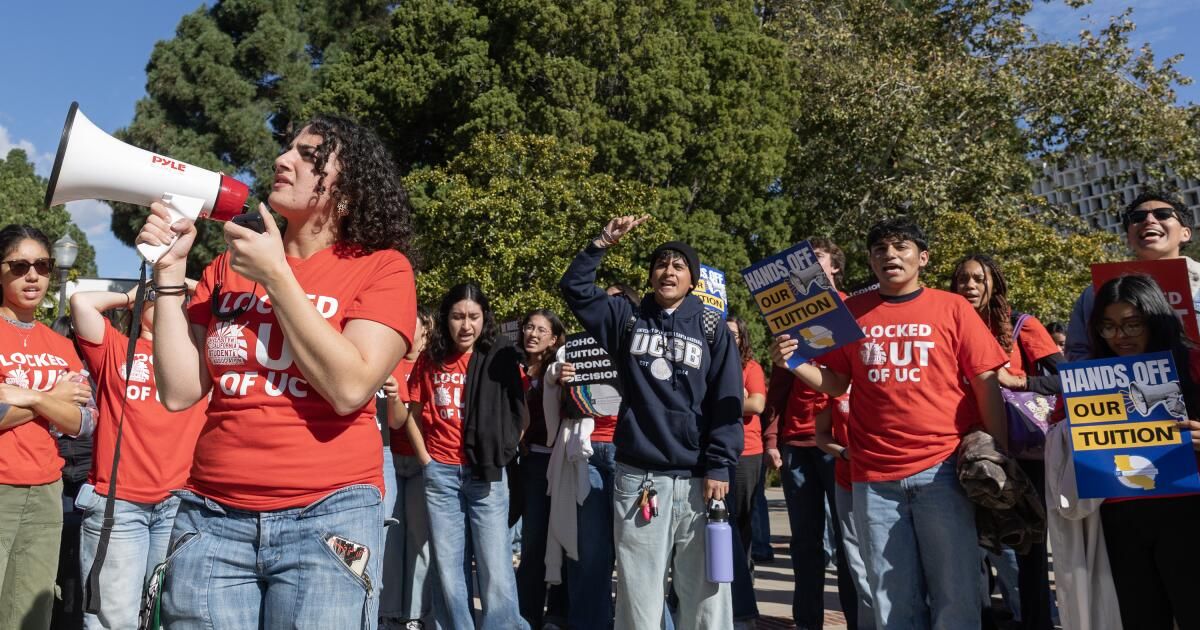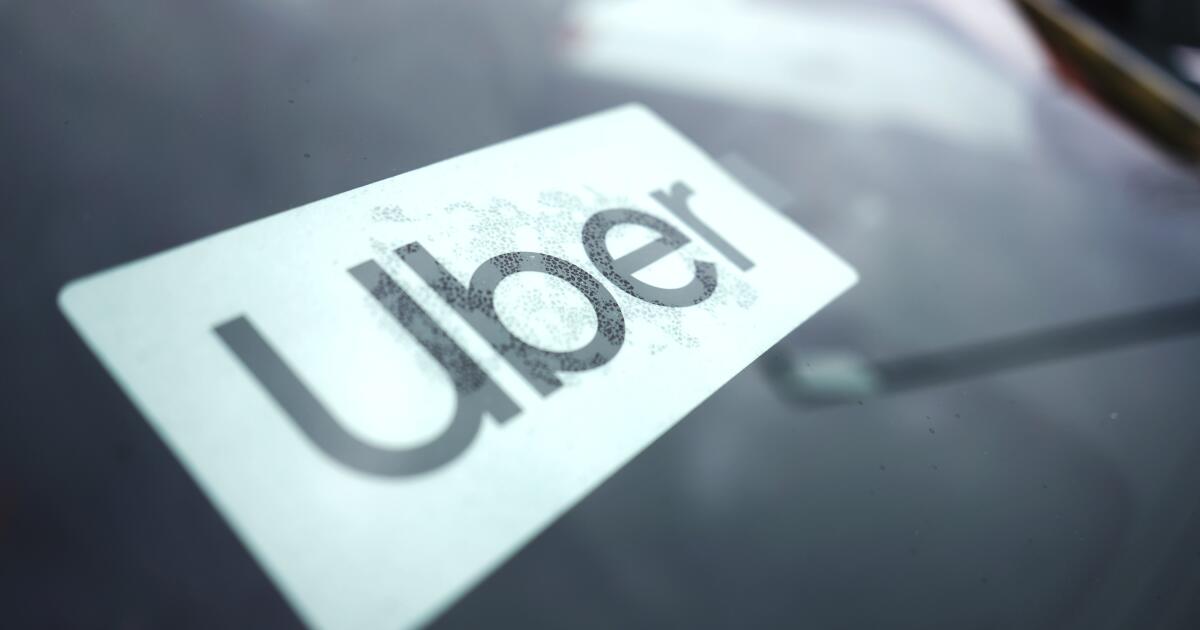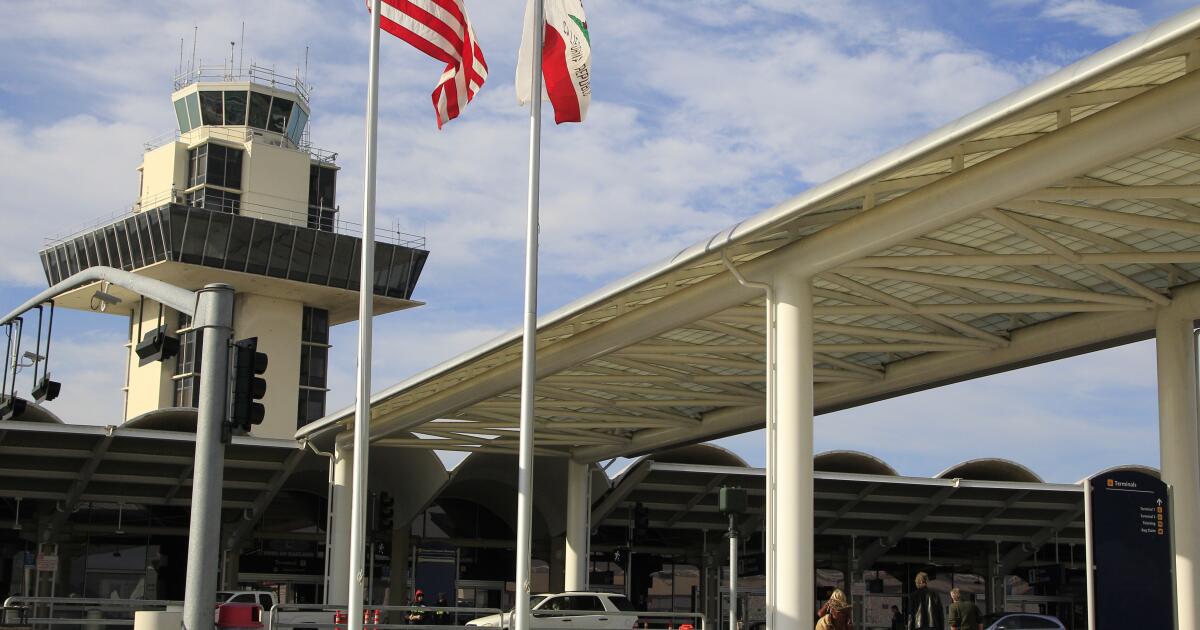Faced with rising costs and dwindling state and federal funding, University of California regents on Wednesday approved a tuition increase praised by UC leaders but fiercely opposed by students.
The board voted 13-3, with eight regents absent, to renew a controversial “enrollment stability” program adopted five years ago that UC officials say provides long-term predictability for students and parents while generating much-needed cash flow at a time of campus-level deficits, a $130 million cut in state money, hundreds of layoffs this year and uncertainties about Trump administration funding.
The plan caps inflation-based increases at 5% each year and then locks in that rate for the duration of school for each new incoming cohort. It will also reduce the proportion of tuition revenue that goes to financial aid by 5%.
“Tuition increases are never welcome, but moderate and predictable increases are necessary to maintain the quality of education our students deserve,” said UC President James B. Milliken, who expressed his support during his remarks at the board of trustees meeting on the UCLA campus.
Chancellors, he said, “need the tools we can give them to maintain the quality and access of the University of California, and that includes, importantly, extending the Enrollment Stability Plan.”
But inside and outside the Meyer and Renee Luskin Conference Center, where the regents met, hundreds of students — speaking through oral and written public comments and at a rally that drew representatives from all nine university campuses — seemed almost uniformly opposed.
“I think I speak for the student body when we say that we vehemently oppose this increase in tuition,” said Tommy Contreras, internal vice president of undergraduate student government at UCLA. “Historically, UC has prided itself on being an engine of socioeconomic mobility, and this enrollment increase goes directly against that mission.”
They said many students already struggle with debt to pay for classes, books, food and housing in expensive neighborhoods, including Westwood and Santa Barbara, where most campuses are located.
“Hey, hey, ho ho, tuition increases need to go away!” said a group of student government leaders and supporters gathered outside the building wearing bright red T-shirts with the words “excluded from UC.”
Why UC says tuition should increase
The original enrollment stability program, which expires next year, also faced strong opposition. But UC leaders say this has resulted in lower tuition rates compared to tying costs strictly to inflation. It also keeps tuition lower than many competing public universities outside of California.
“We recognize that in addressing any enrollment issue, we are making decisions that deeply affect our students and our future students,” UC Board of Trustees President Janet Reilly said during her remarks Wednesday.
But, he said, “as we approach the conclusion of the fall 2026 application cycle, we clearly see the positive effects this plan has had… Since its implementation in 2022, more than half of California college students, about 54%, have received enough aid to fully offset the tuition increases and additional resources that have helped cover room, board and books.” About 64% of college students, he said, also graduate debt-free.
Leaders said rising enrollment in the coming years, coupled with financial strains — UC recently requested a $130 million interest-free loan from California to offset the loss of state funding — has made annual increases more urgent.
A UC report compiled over the summer found that instructional spending per student has declined compared to levels two decades ago. The student-to-faculty ratio has worsened, and student support programs and faculty salaries have fallen short of the university's goals, in addition to growing backlogs in campus maintenance.
Under the Trump administration, UC has also faced other financial challenges: $230 million in federal research grants on hold and uncertainty about the $17.5 billion in federal support UC receives each year.
How the tuition program works
California undergraduates entering in fall 2022 (the first year of the program) paid a steady annual tuition of $13,104. Those who began schooling in later years pay a higher amount tied to inflation and rising costs.
With annual increases, based on three-year averages of the California Consumer Price Index, each class pays more than the one before it. For undergraduates entering this fall, tuition is $14,934 for California residents and $50,328 for non-residents. Non-residents include international and out-of-state students.
Estimates for housing, food, course materials, supplies, equipment, health insurance, and transportation are different on each campus. For UCLA, students living in university housing would pay approximately $28,203 to cover those costs, bringing the annual price to $43,137 for California residents before financial aid.
There are some changes in the new policy.
Tuition increases are tied to inflation rates and may be lower than the 5% limit, as they have been in recent years. If inflation increases more than 5% in a year, any percentage above 5% can be accumulated to be used for a tuition increase in a future year. The plan also incorporates an additional 1% increase on top of inflation-based increases to cover capital improvements or other projects.
Additionally, the new policy reduces the proportion of tuition allocated to financial aid to 40%, down from 45% currently.
Shawn Brick, UC associate vice chancellor for student financial aid, said in an interview that the change would not reduce UC's focus on helping low- and middle-income students. Brick said the plan “was not a reduction in financial aid” and that UC could better help with “inflationary costs that impact non-tuition educational expenses.”
What the board said
On Wednesday, UC Student Regent Sonya Brooks said she opposed the plan.
“We've had several increases in student suicides, hospitalizations, basic needs crises… Before we approve an enrollment model, can we at least have some type of assessment of the campus's ability to support student well-being and the projected impact of this plan on retention and educational outcomes?” said Brooks, who voted against.
Brick responded that the tuition plan “generates revenue that can then help offset those non-tuition costs.” He added that “student debt has actually been declining at the undergraduate level over the last few years. We're down to about 35%-36% of [California resident] students graduating with debt… I would say some of that we could certainly attribute to the enrollment stability plan.”
Regent Eleni Kounalakis, who voted against it, said the increase “really worries me.”
“Over the course of the last few decades, the concept of who can come to UC has really changed,” he said. “Tuition when I was a student in the graduate program in the '90s was about $4,500 a year. Now it's $77,000 for that young man who has an MBA (at UC Berkeley). What happened? … In fact, from 2012 to 2021 we barely increased tuition. The increase was negligible for almost 10 years, and we managed to keep tuition low as costs rose.”
Regent and Vice President Maria Anguiano said she was concerned that “there is no mechanism for the regents to review this again. And I think good governance really requires that the regents periodically review our tuition policy. So I would like to propose an amendment to review this again in seven years.” Anguiano also suggested that campuses be allowed more flexibility in how they use the 1% premium on top of inflation-based increases.
Both changes were added as amendments to the final vote.
Regent Rich Leib agreed. “I think it's always good to talk about enrollment at a certain time. And I also think some flexibility on campus would be good,” Leib said.
Regent Michael Cohen said he supported the plan.
“You know what the price is when your student enrolls, and in fact, compared to inflation, it's getting cheaper year after year – the total dollar amount remains stable from year to year,” Cohen said. “But as the costs of eggs, food and gasoline increase, the cost to UCLA or another campus decreases in real terms.”
Regent Ana Matosantos also expressed support, saying predictability and limits on tuition increases were important.
But, she added, “I wasn't the biggest fan of the change on the return-to-aid side of the equation. I was more interested in seeing more of those additional dollars go toward other student aid, toward housing, toward things related to (being) debt-free.”
Regent Lark Park asked UC financial officials for more information on total education costs. “There are substantial non-tuition costs and sometimes I feel like we focus too much on tuition at the expense of discussing some of these other cost increases that, again, are part of the total cost of attendance.”
Students oppose
Speaking at the regents meeting and early morning rally, UCLA students said tuition should remain flat or be assessed to increase each year, as it was before the enrollment stability plan was first adopted.
“It reduces access. It will increase the disparity between extremely low-income students and extremely high-income students, which increases the divide,” said Arelys Placido, a UCLA student who works for the undergraduate student body government office.
Edgar Pedroza Moreno, a freshman at UC Santa Barbara, said he was against the increase because he had already experienced the high costs of education by having to take out $20,000 in loans for his first year of school.
“That is with financial aid,” Moreno said. “It's going to be very difficult to pay it off.”
“It costs too much to go to college. That's why I almost didn't go to Santa Barbara because it was almost impossible to pay unless I got the loans. I'll have to go into a lot of debt for just a year's time to get my degree.”












